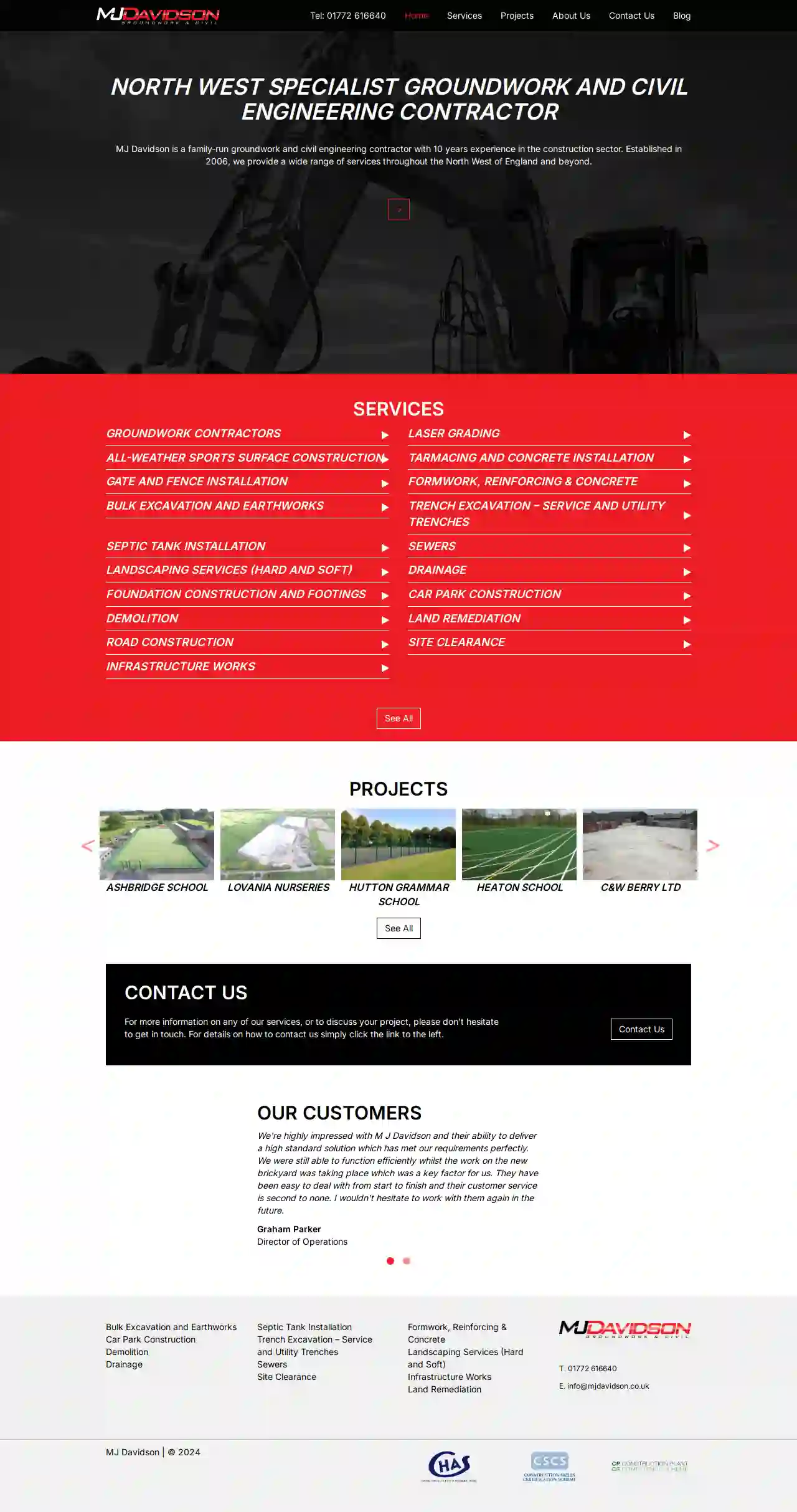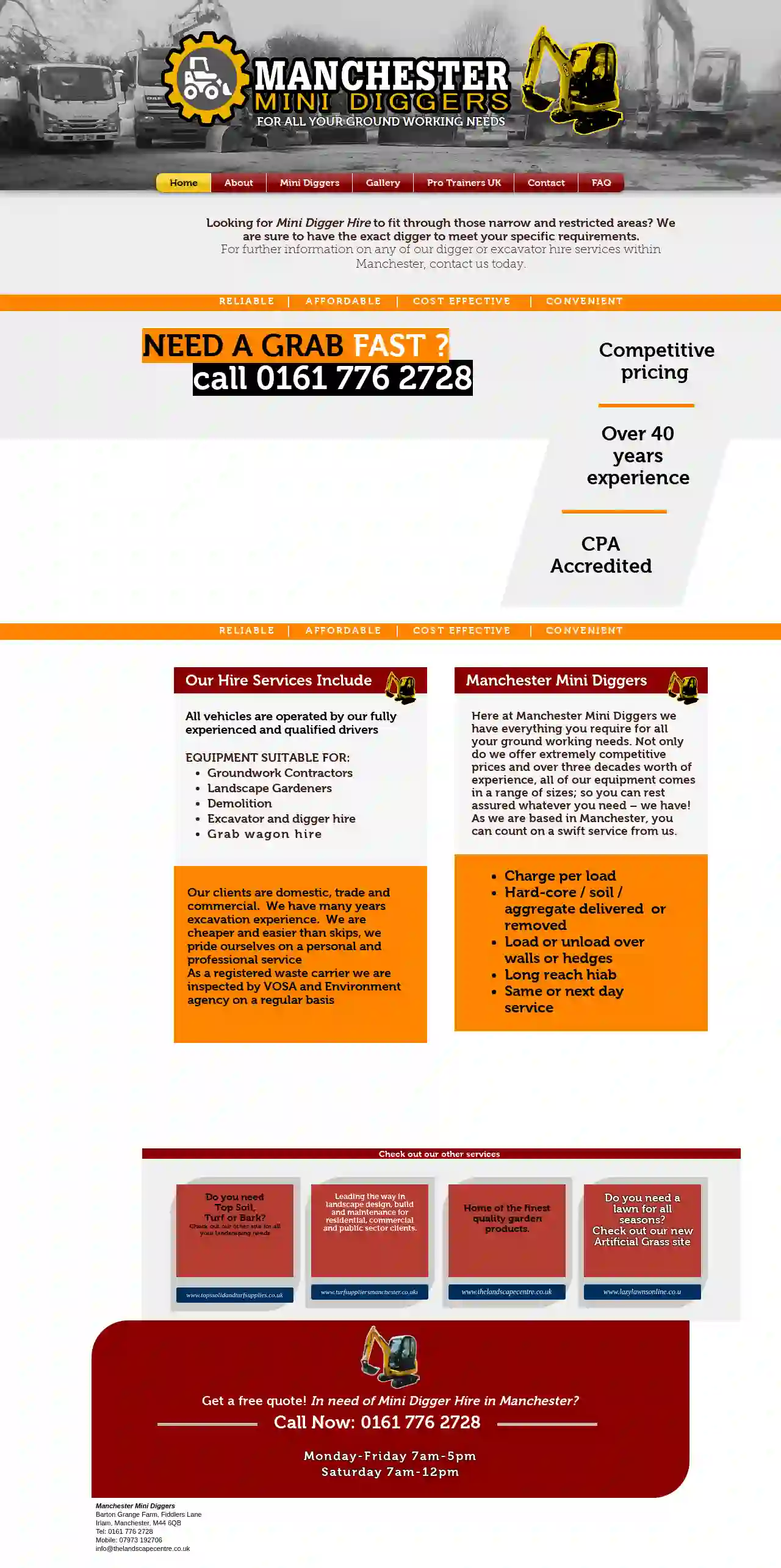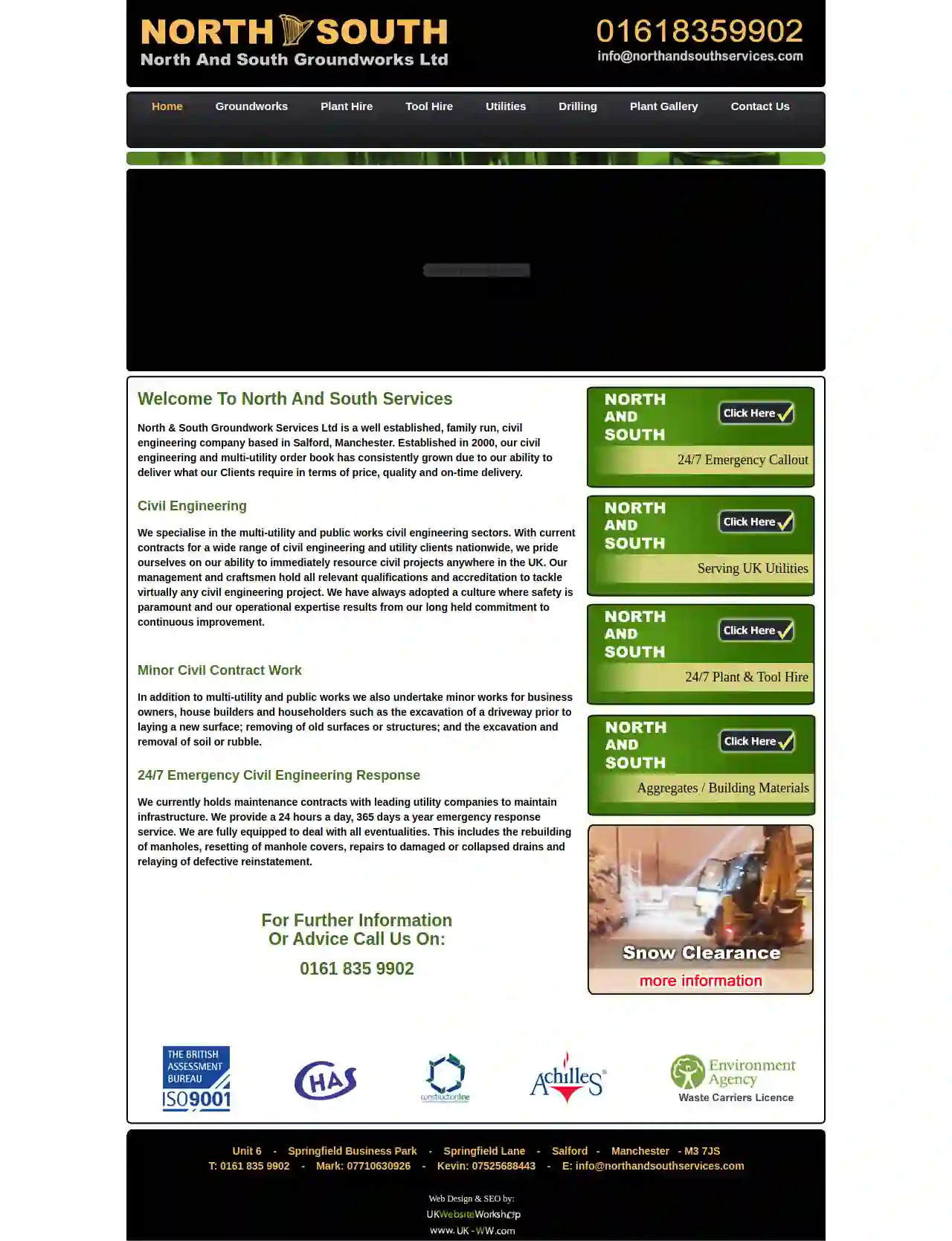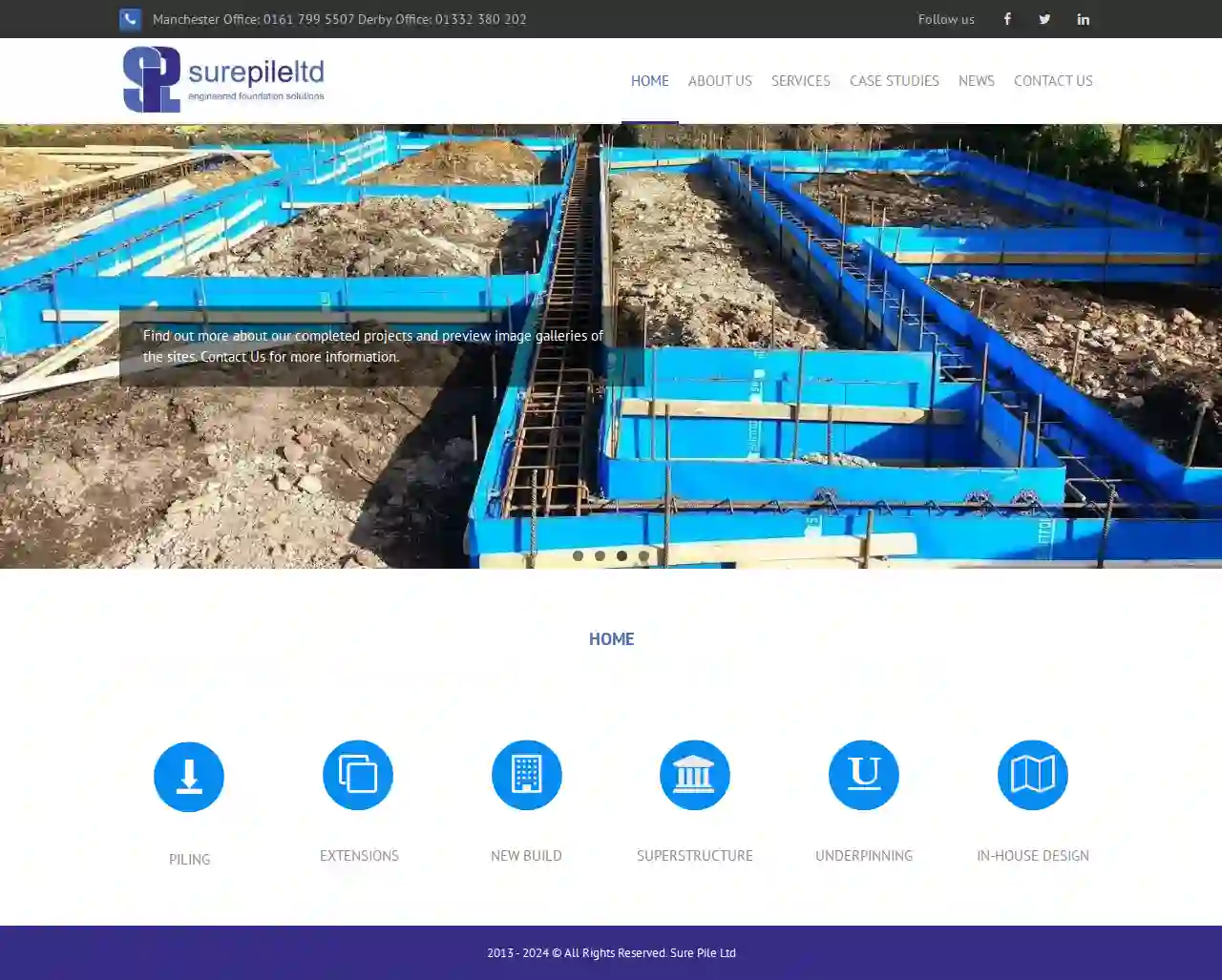Demolition Contractors Baguley
Top 10 Demolition Services in Baguley
Receive 3 FREE Demo Companies quotes for your project today! Compare profiles, reviews, accreditations, portfolio, etc... and choose the best offer.

MJ Davidson Groundworks Ltd
51 reviewsManchester, GBMJ Davidson: Your Trusted Groundwork and Civil Engineering Partner MJ Davidson is a family-run groundwork and civil engineering contractor with over a decade of experience in the construction sector. Established in 2006, we've built a strong reputation for delivering high-quality, reliable services throughout the North West of England and beyond. Our commitment to excellence, combined with our experienced team, ensures that every project is completed to the highest standards, on time and within budget. We understand that every project is unique, and we take the time to listen to our clients' needs and develop tailored solutions that meet their specific requirements. Whether you're a homeowner, developer, or commercial business, we have the expertise and resources to handle projects of all sizes. At MJ Davidson, we pride ourselves on our strong work ethic, dedication to customer satisfaction, and commitment to safety. We believe in building lasting relationships with our clients, and we're always available to answer your questions and provide support throughout the entire project lifecycle.
- Services
- Why Us?
- Testimonials
- Gallery
Get Quote
North West Ground Work & Building Services
2 Ashfield House Gardens, Standish, WN6 0FA, GBMicro & Mini Digger with Driver Hire Our comprehensive fleet of mini and micro diggers is available around the clock for all your urgent needs. Equipped with hydraulic breakers, grabs, and augers, we’re prepared to tackle any challenge, anytime. Demolition Work - Site Clearance - Drainage Footings - Driveways - Gardens Dug Out Welcome to North West Ground Work & Building Services, your trusted partner for all groundwork and excavation needs in Wigan and the surrounding areas. With over two decades of industry experience, we are committed to delivering top-notch services that cater to your construction requirements. 24/7 Emergency Call-Out Service We pride ourselves on specialising in all aspects of groundwork and excavation services. Our fleet includes a comprehensive range of mini and micro diggers, ensuring we have the right equipment for any job, big or small. Our cost-effective services are tailored to meet your needs and include: Micro & Mini Digger with Driver Hire: Efficient and reliable digger hire with experienced operators. Demolition Work: Safe and controlled demolition services for residential and commercial projects. Site Clearance: Thorough site preparation and clearance to ensure a clean and ready-to-build environment. Drainage Footings: Professional installation and repair of drainage systems to prevent water-logging and maintain structural integrity. Driveways: Durable and aesthetically pleasing driveway installations that enhance the value and appearance of your property. Gardens Dug Out: Expert garden excavation services for landscaping, redesign, and construction purposes. For a free, no-obligation quote, please contact us at 07860 391 538 or email us at [email protected]. We are here to provide the best groundwork and excavation solutions for your project.
- Services
- Why Us?
- Testimonials
- Gallery
Get Quote
Geotron UK Ltd
410 reviewsUnit E201B, Warmco Industry Park, Eastgate, Warmco Industry Park Eastgate Manchester Road Mossley, Mossley, OL5 9AY, GBWho We Are Geotron UK provide land drilling and vacuum excavation services to support our clients during environmental and geotechnical site investigation and contaminated land remediation programmes. Our unique combination of specialist rigs, experienced and knowledgeable people and a desire to excel in everything that we do make Geotron UK a preferred supplier of drilling and excavation services for environmental and geotechnical consultants, contractors and corporate clients alike. For up to date information on the current activities of our teams throughout the UK please follow us on social media! In May 2022 Geotron UK clocked up 20 years in business. To celebrate we hosted an Open Day on Saturday 7th May at our Mossley HQ. It was a fabulous day and a great opportunity to thank our clients, suppliers, team members, friends and family for all their support over the years.
- Services
- Why Us?
- Gallery
Get Quote
Manchester Mini Diggers
52 reviewsBarton Grange Farm, Fiddlers Lane, Irlam, M44 6QB, GBManchester Mini Diggers: Your Trusted Partner for Groundwork Needs Looking for reliable and efficient mini digger hire in Manchester? Look no further than Manchester Mini Diggers. We've been serving the area for over 40 years, providing top-notch service and competitive pricing. Our team of experienced and qualified operators ensures that your project is completed to the highest standards. We understand that every project is unique, which is why we offer a wide range of mini diggers and excavators to suit your specific requirements. Whether you're a homeowner, contractor, or commercial business, we have the right equipment for the job. Our services include: Excavator and digger hire Grab wagon hire Hard-core, soil, and aggregate delivery and removal Load and unload over walls or hedges Long reach hiab Same or next day service We pride ourselves on our personal and professional service, and we're always happy to answer any questions you may have. Contact us today for a free quote!
- Services
- Why Us?
- Accreditations
- Gallery
Get Quote
B J Crowther Limited
44 reviewsWindsor House, Windsor Street, Oldham, OL1 4AE, GBOur success lies on our ability to provide a consistently high standard of quality, efficiency and service focusing on our clients objectives. The company, based in Oldham, was founded by Bernard James Crowther in 1966 and further developed into a successful family partnership. In February 1998 subsequent to a substantial increase in growth, B J Crowther became a Limited Company. Phillip Crowther the Managing Director has succeeded in strengthening the companies reputation and expertise and we have progressed into a leading Bulk Excavation and Groundwork contractor. Our commitment to Health and Safety is paramount and we constantly invest in our staff providing training and support to ensure we sustain a skilled and competent workforce. We strive to reduce our environmental impact and execute the appropriate measures within all our activities, including the incorporation of a recycling depot within our premises for the provision of recycled aggregates to our clients.
- Services
- Why Us?
- Gallery
Get Quote
North And South Services Ltd
Unit 6, Springfield Lane, Springfield Business Park, Salford, M3 7JS, GBWelcome To North And South Services North & South Groundwork Services Ltd is a well established, family run, civil engineering company based in Salford, Manchester. Established in 2000, our civil engineering and multi-utility order book has consistently grown due to our ability to deliver what our Clients require in terms of price, quality and on-time delivery. Civil Engineering We specialise in the multi-utility and public works civil engineering sectors. With current contracts for a wide range of civil engineering and utility clients nationwide, we pride ourselves on our ability to immediately resource civil projects anywhere in the UK. Our management and craftsmen hold all relevant qualifications and accreditation to tackle virtually any civil engineering project. We have always adopted a culture where safety is paramount and our operational expertise results from our long held commitment to continuous improvement. Minor Civil Contract Work In addition to multi-utility and public works we also undertake minor works for business owners, house builders and householders such as the excavation of a driveway prior to laying a new surface; removing of old surfaces or structures; and the excavation and removal of soil or rubble. 24/7 Emergency Civil Engineering Response We currently holds maintenance contracts with leading utility companies to maintain infrastructure. We provide a 24 hours a day, 365 days a year emergency response service. We are fully equipped to deal with all eventualities. This includes the rebuilding of manholes, resetting of manhole covers, repairs to damaged or collapsed drains and relaying of defective reinstatement.
- Services
- Why Us?
- Our Team
- Gallery
Get Quote
Huck Construction Ltd
44 reviewsBack Lane Hale Nook, Preston, PR3 6TU, GBWELCOME TO HUCK CONSTRUCTION A commitment to SERVICE, a commitment to QUALITY At Huck Construction we strongly believe in building a personal rapport with our customers to develop a better understanding of their requirements and expectations. It is this commitment which has seen us develop into a complete service contractor, taking projects from conception through design and build to finished landscaping. Experience Huck Construction Ltd has gained an excellent reputation for undertaking high quality work. Working on projects in the Industrial, Commercial, Residential, Health, Education & Leisure industries and often being invited to quote for additional work after the projects are finished. Creativity We have carried out the construction of New Builds, Industrial Estates, Welfare Centres, Open Workshops, Office Blocks, New Factory Units, but also restored and refurbished existing units back to full working order. Quality Huck Construction Ltd relies on excellent standards, attention to detail, customer service and strict deadlines to exceed our clients expectations and make us ideal candidates for future opportunities.
- Services
- Why Us?
- Gallery
Get Quote
Lee's Solutions Ltd
5130 reviews53 Baltimore Rd, Lytham St Annes, FY8 3NY, GBAsbestos disposal and concrete garage company in Lytham St Annes, Preston & Blackpool Lee's Solutions Ltd are a well established family run business offering professional asbestos removal services, specifically for new garages and new bases. We have over 15 years' experience undertaking both domestic and commercial work. Everything is carried out to the highest standards and at a competitive price too. Our service is comprehensive, covering design and installation work, as well as the dismantling and disposal of any old asbestos-lined garages. We provide supporting documentation for any cement-bonded asbestos that we have removed for you and all our employees are fully trained and insured. Give us a call today for a quote! What we do Asbestos management Garage demolition Garage roofs Fully licensed and insured New garage sales Garage repairs What our customers say "Asbestos garage removed and concrete base laid. Great job done. Punctual, methodical, tidy and thoroughly professional, I would recommend without hesitation." StephenB-1254 (Yell.com review) "Great company, here on time, got straight into job and tidied up well afterwards, good job, would definitely recommend them." SarahL-848 (Yell.com review) "Removed old garage and laid a new concrete base. Excellent job, really helpful and informative, arrived on time, highly recommended. Will be using again." NeilR-377 (Yell.com review)
- Services
- Why Us?
- Testimonials
- Gallery
Get Quote
Paul Hetherington Groundworks Limited
53 reviewsPark Lane Poultry Farm, Forton, Preston, Lancashire, GBPaul Hetherington Groundworks Ltd Paul Hetherington Groundworks Ltd is an established, family-run groundworks company in Lancashire with many years of experience specialising in commercial and residential properties. Based out of The Poultry Farm, Lancashire strategically located within 5 miles of the M6 motorway, Paul Hetherington Groundworks Ltd are able to provide an efficient groundworks service anywhere North of Preston and South of Carlisle. We run a modern, well maintained and very capable fleet of vehicles and machinery and a highly qualified and experience workforce.
- Services
- Why Us?
- Testimonials
- Gallery
Get Quote
Sure Pile Ltd
45 reviewsManchester, GBSure Pile Ltd. is a specialist civil engineering company operating throughout the United Kingdom. Based in Manchester and Derby, we are able to provide a cost effective solution to our clients. We offer a wide range of services including mini piling, underpinning, extensions, new build, superstructure works and in-house design. We are committed to continuous improvement, with all employees fully trained and Health & Safety compliant. Find out more about our completed projects and preview image galleries of the sites.
- Services
- Why Us?
- Gallery
Get Quote
Over 13,059+ Excavation Pros in our network
Our excavation contractors operate in Baguley & surroundings!
ExcavationHQ has curated and vetted Top Excavation Contractors arround Baguley. Find the most trustworthy contractor today.
Frequently Asked Questions About Demolition Contractors
- Dust Suppression: Use water spraying, misting systems, or other dust suppression techniques to control airborne particles.
- Noise Barriers: Erect temporary noise barriers around the demolition site to reduce noise transmission to nearby properties.
- Work Schedule: Schedule noisy demolition activities during permitted hours to minimize disturbance to neighbors.
- Communication: Keep neighbors informed about the demolition schedule and any potential disruptions.
- Permits and Regulations: Obtain all necessary demolition permits and comply with local building codes and environmental regulations.
- Contracts: Have a clear and comprehensive contract with the demolition contractor outlining the scope of work, payment terms, and liabilities.
- Environmental Laws: Comply with environmental laws regarding hazardous material removal, waste disposal, and pollution control.
- Neighboring Property Rights: Respect neighboring property rights and take measures to prevent damage or disruption to adjacent properties.
- Worker Safety: Adhere to worker safety regulations and provide a safe working environment for demolition crews.
- Feasibility Studies: Assessing the viability and challenges of a demolition project.
- Demolition Planning: Developing demolition plans, including method selection, sequencing, and safety procedures.
- Permitting Assistance: Navigating the demolition permitting process and ensuring compliance with regulations.
- Hazardous Material Surveys: Identifying and managing hazardous materials, such as asbestos and lead paint.
- Cost Estimating: Providing accurate cost estimates for demolition services.
- Project Management: Overseeing the demolition process and ensuring it proceeds as planned.
How can I minimize the dust and noise from demolition?
What are the legal considerations for demolition projects?
What is the role of a demolition consultant?
What is a demolition bond?
How can I minimize the dust and noise from demolition?
- Dust Suppression: Use water spraying, misting systems, or other dust suppression techniques to control airborne particles.
- Noise Barriers: Erect temporary noise barriers around the demolition site to reduce noise transmission to nearby properties.
- Work Schedule: Schedule noisy demolition activities during permitted hours to minimize disturbance to neighbors.
- Communication: Keep neighbors informed about the demolition schedule and any potential disruptions.
What are the legal considerations for demolition projects?
- Permits and Regulations: Obtain all necessary demolition permits and comply with local building codes and environmental regulations.
- Contracts: Have a clear and comprehensive contract with the demolition contractor outlining the scope of work, payment terms, and liabilities.
- Environmental Laws: Comply with environmental laws regarding hazardous material removal, waste disposal, and pollution control.
- Neighboring Property Rights: Respect neighboring property rights and take measures to prevent damage or disruption to adjacent properties.
- Worker Safety: Adhere to worker safety regulations and provide a safe working environment for demolition crews.
What is the role of a demolition consultant?
- Feasibility Studies: Assessing the viability and challenges of a demolition project.
- Demolition Planning: Developing demolition plans, including method selection, sequencing, and safety procedures.
- Permitting Assistance: Navigating the demolition permitting process and ensuring compliance with regulations.
- Hazardous Material Surveys: Identifying and managing hazardous materials, such as asbestos and lead paint.
- Cost Estimating: Providing accurate cost estimates for demolition services.
- Project Management: Overseeing the demolition process and ensuring it proceeds as planned.